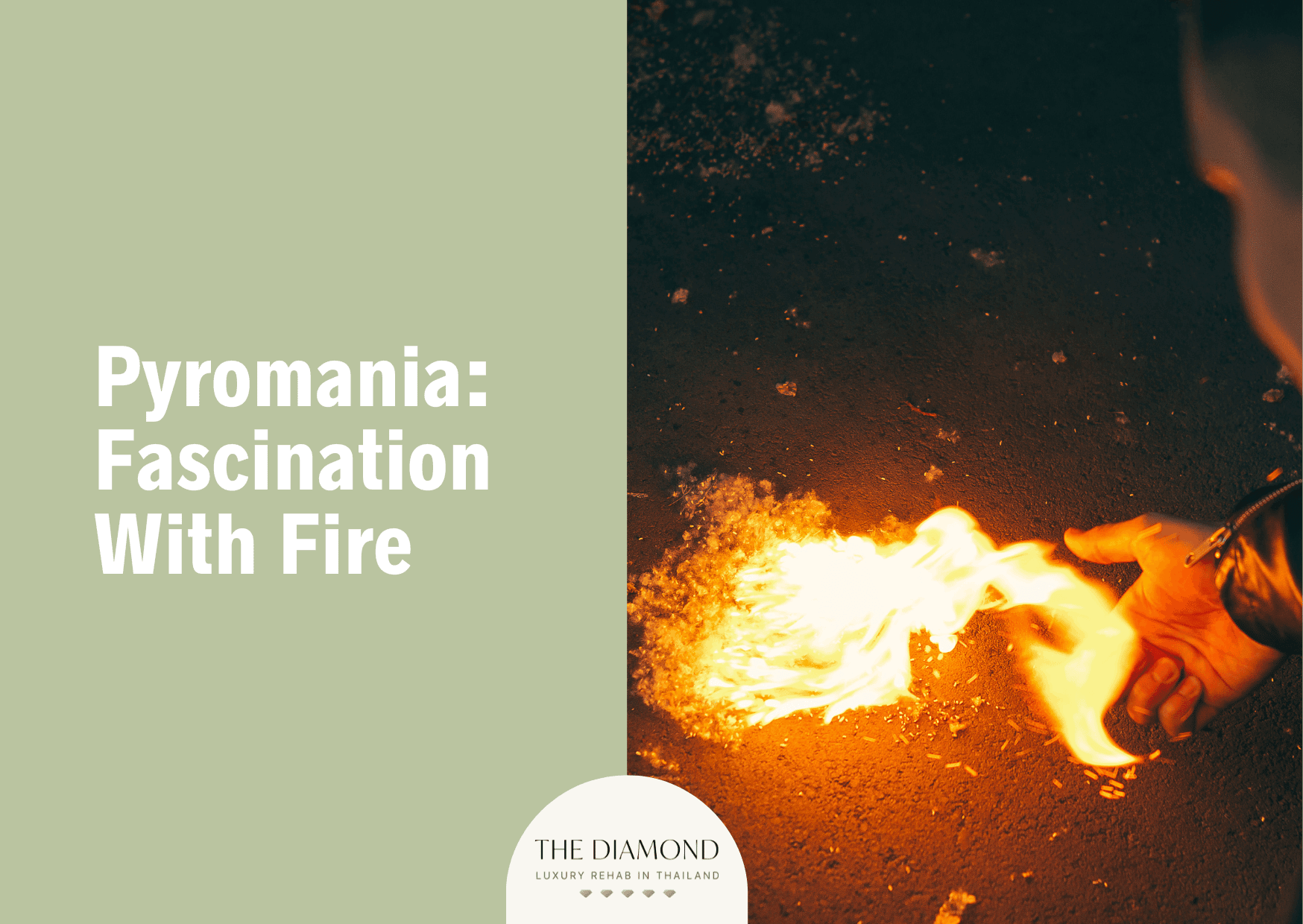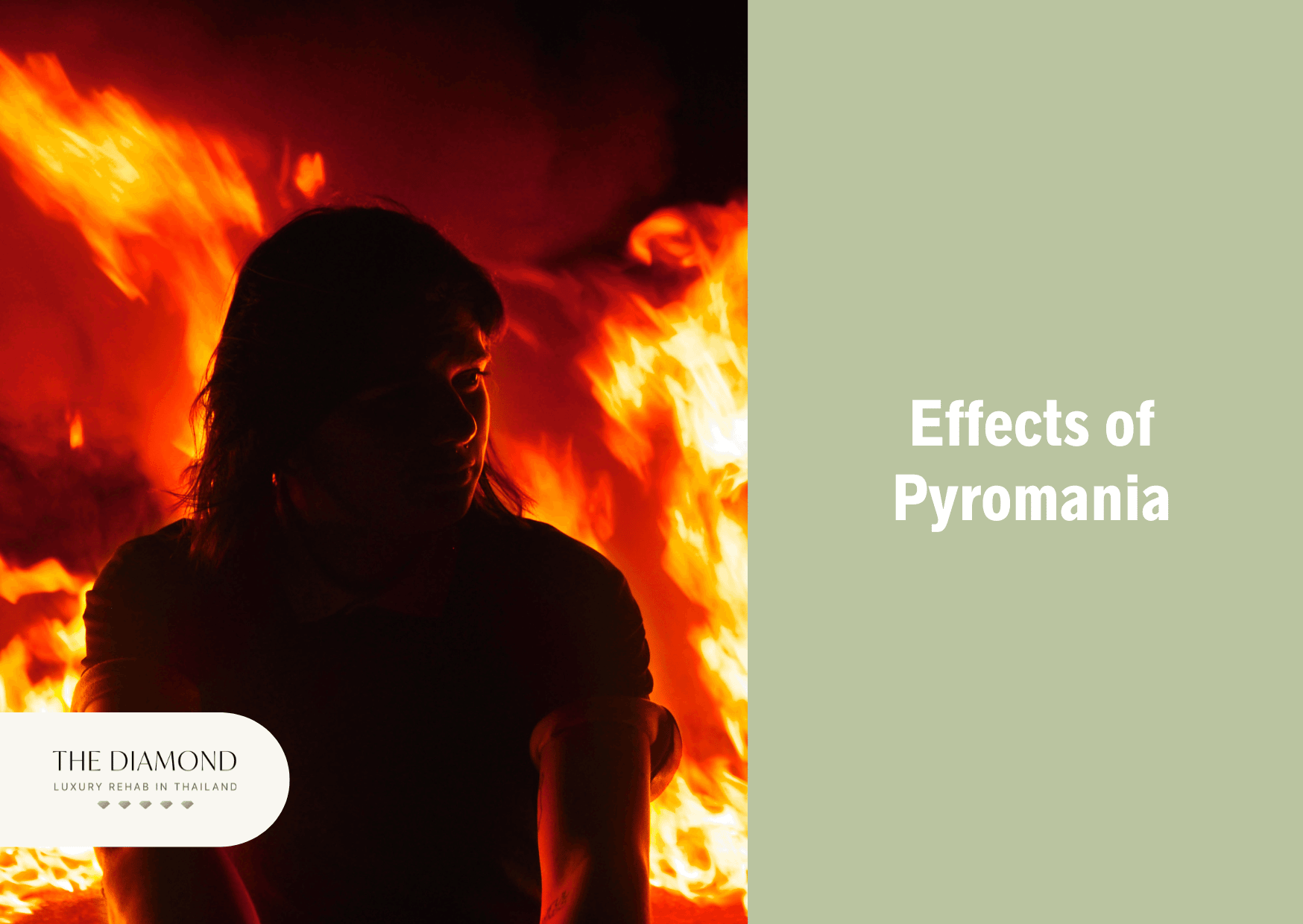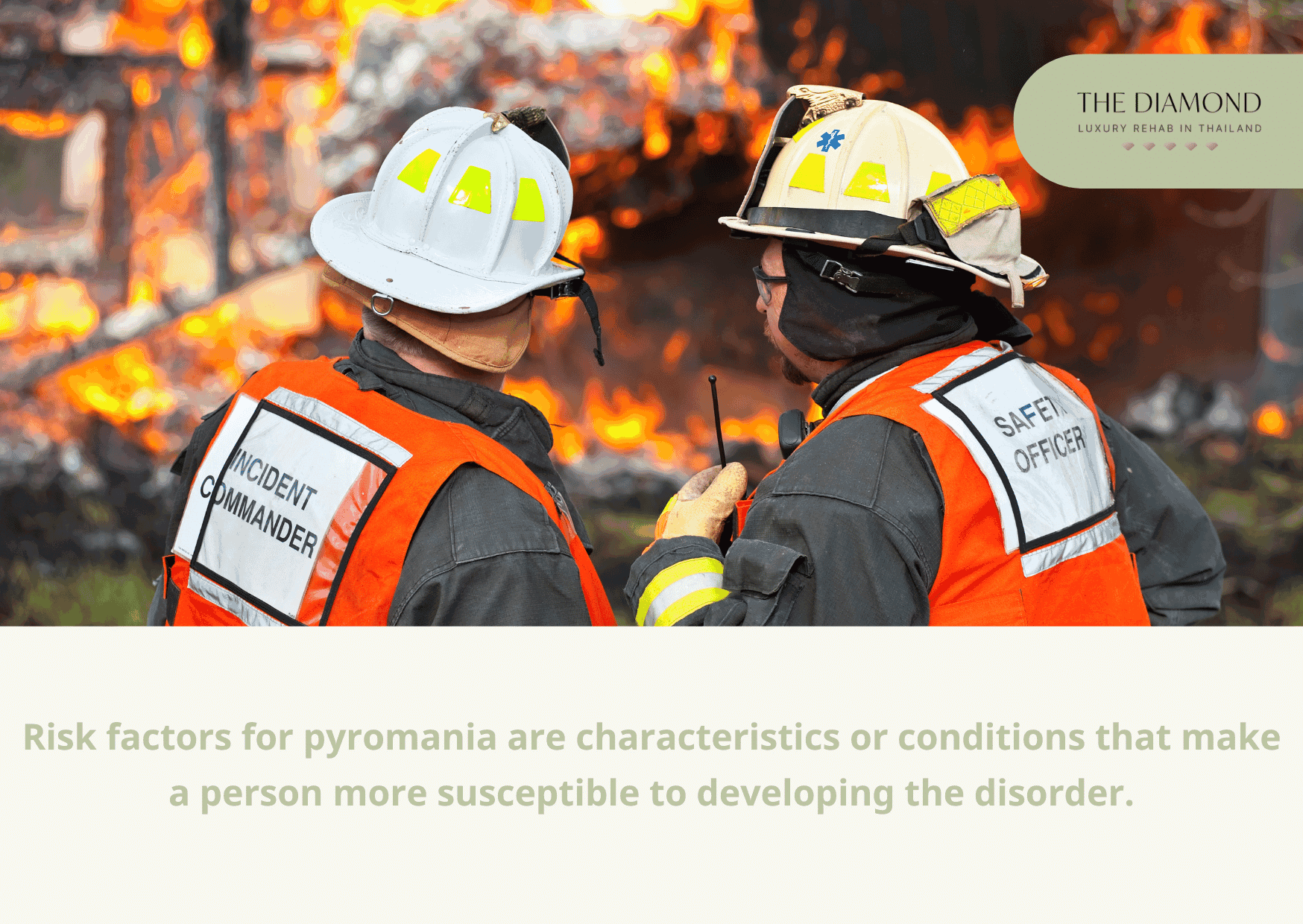Pyromania: fascination with fire

Pyromania is a rare impulse control disorder in which a person is unable to resist an overpowering urge to start fires. Signs that are indicative of the disorder often start to surface in childhood and in rare cases, as young as three years old.
The symptoms of pyromania include a pattern of intentional fire setting, feelings of tension or arousal before starting a fire, an unhealthy obsession with fire and related paraphernalia, and a sense of relief or gratification when starting or watching fires. The destructive behaviors involved in pyromania can easily lead to negative consequences.
The effects of pyromania include damage to property, harm to other people, an increased risk of injury, potential incarceration of the afflicted person, and even death.
Problematic fire-setting also has certain distinct characteristics, such as multiple recurrences of intentional fire setting, a build-up of tension leading to the act, emotional release after deliberately starting a fire, the absence of a reasonable motive to commit the act, and making advance preparation for starting a fire.
Upon receiving a pyromania diagnosis, seeking treatment is imperative to avoid the serious repercussions of the disorder. The most common treatment options for pyromania are cognitive behavioral therapy (CBT) and the use of medications.
What is Pyromania?
Pyromania is characterized by intentional and repeated fire setting on multiple occasions. People with this condition often experience a buildup of tension that can only be relieved by engaging in fire-setting behavior.
The emotional rush obtained from committing the act also motivates a pyromaniac to repeatedly engage in the destructive act of starting a fire.
What is the cause of Pyromania?
The causes of pyromania include genetics, co-occurring psychological disorders, stressors, and brain chemical imbalance.
Pyromania is most commonly comorbid with gambling disorder, anxiety, depression, bipolar disorder, substance use disorder, learning disabilities, depressive disorders, and antisocial personality disorder.
As with other impulse-control disorders, problematic fire-setting may also be influenced by genetics. Having certain genes that are associated with impulsivity may alter the function of neurotransmitters in the brain that regulate impulse control, according to a 2013 study on the genetics of impulsive behaviour published in Philosophical Transactions of the Royal Society B.
The disorder is also rooted in life event stressors, including a history of abuse, childhood trauma, neglect, and family dysfunction. The onset of pyromaniac symptoms can also be triggered by imbalances in the dopamine and serotonin systems in the brain, which are both involved in impulsivity, according to a 2012 review by J.W. Dalley and J.P. Roiser published in Neuroscience.
What are the effects of Pyromania?
The effects of pyromania can be serious and may affect an individual psychologically, socially, and even legally. The effects of pyromania are listed below.
- Harm to other people: Unlike arson, pyromania does not come with the intent to harm other individuals. However, the absence of this intent does not guarantee that no one will be hurt by the act. After all, fire-setting activity is risky and may put other people at risk of being harmed or sustaining injuries. In some cases, a pyromaniac may also be apathetic toward the people who will be negatively affected by their actions and may even obtain pleasure from seeing the aftermath of a fire.
- Damage to property: A fascination with fire can lead a person to set fire to a structure or another individual’s property. Similarly, someone with pyromania may also derive satisfaction from causing property damage.
- An increased risk of injury: Repeated engagement in fire-setting behavior causes an increased risk for injuries or burns, both for the afflicted person and the people around them.
- Potential incarceration: A pyromaniac could potentially be convicted and incarcerated for arson due to their habit of frequently starting fires. Although an arsonist may suffer from pyromania, most arsonists are not diagnosed with the condition.
- Death: Impulses related to problematic fire-setting can manifest in a dangerous manner, leading to fatal consequences. If left untreated, pyromania can result in the loss of innocent life.

What are the characteristics of Pyromania?
The characteristics of pyromania include distinct features that set it apart from arson. The most common characteristics of pyromania are listed below.
- Multiple recurrences of intentional fire setting: People with pyromania engage in multiple attempts of intentional fire setting to relive feelings of instant gratification and relief derived from the act.
- A build-up of tension leading to the act: Pyromania causes a person to feel tense or excited before setting a fire. This build-up of tension can only be released once a fire has been started.
- Emotional release after deliberately starting a fire: Pyromaniacs often experience an emotional rush or relief from tension and anxiety after starting fires. In some cases, however, people with the condition may also suffer from feelings of guilt after committing the act, especially if they have been trying to control their impulses for a while.
- The absence of a reasonable motive to commit the act: An individual with pyromania does not engage in fire-setting behaviors for financial gain, revenge, anger, or political expression, according to chapter 20 of the book Functional Analysis in Clinical Treatment (Second Edition) published by the Academic Press. Someone who has done fire setting to conceal criminal activity or in response to signs of psychosis would also not be diagnosed with pyromania. This is because the disorder is strictly a result of uncontrolled impulses and powerful feelings to act on these urges.
- Making advance preparation for starting a fire: A pyromaniac may spend a huge amount of time planning for fire setting in advance. For instance, a person with the condition may look for abandoned or unfinished buildings weeks before committing the actual act in the location.
Other known characteristics of pyromania include:
- A tendency to be a regular watcher of fires
- A tendency to set off false fire alarms
- A deep fascination with fires and related paraphernalia
- Gaining pleasure from being associated with fire departments or firefighters
- Obtaining pleasure from obsessing about the destruction and significant risks of fires
What are the signs and symptoms of Pyromania?
The symptoms of pyromania represent indications that someone may be engaging in destructive behaviors around fire-starting. The signs and symptoms of pyromania are listed below.
- A pattern of deliberate fire setting: As pyromaniacs find it difficult to resist impulses to intentionally set fires, they may get caught up in a continuous cycle of firesetting to relieve tension or anxiety related to the impulses.
- Feelings of tension or arousal before starting a fire: Along with powerful urges to start fires, individuals with pyromania also experience increasing tension which they feel can only be alleviated by giving in to their impulses.
- An unhealthy obsession with fire and related paraphernalia: A person with pyromania disorder tends to develop an obsession with fire and related paraphernalia. As a result, they may collect matches, torches, lighters, or fire accelerants.
- A sense of relief or gratification when starting or watching fires: Pyromaniacs may feel relief from built-up tension and instant gratification upon setting or seeing fires. They may also derive pleasure from their involvement in the aftereffects of the fire.
- An inclination to be associated with fire departments or firefighters: A person’s fascination with fires may also mean engaging in firesetting activity or setting off a false fire alarm to be associated with the local fire department or firefighters.
- Fire-setting behavior does not occur due to malicious intent: An individual cannot receive a diagnosis of pyromania when fire setting stems from monetary gain, anger, revenge, expression of political ideology, or other malicious intent. Patients simply feel powerless over the urges to start fires, hence the repeated engagement in fire-setting activities.
- Fire-setting cannot be better explained by another psychological disorder: The diagnosis of pyromania does not apply if the behavior is part of a mood, conduct, or antisocial personality disorder.
Other symptoms of pyromania include:
- Behavioral symptoms: Playing with fire, collecting fire-setting paraphernalia, staying in a vicinity where a fire has been set, obtaining fire-related work, antisocial behavior, and legal problems
- Physical symptoms: Burns on the skin and other fire-related injuries
- Cognitive symptoms: Obsessive thoughts about fire-starting, high levels of impulsivity, learning disabilities, and poor decision-making skills
- Psychosocial symptoms: Low self-esteem, feelings of shame, anxiety, depression, poor interpersonal skills, and low frustration tolerance
How to overcome Pyromania
The ways to overcome pyromania are self-help strategies that could improve treatment outcomes for individuals battling the condition. The ways to overcome pyromania are listed below.
- Participating in fire safety education: Taking part in fire safety education programs can help educate people who engage in firesetting behaviors about the devastating consequences of fire to human life and property. This is especially beneficial for younger individuals with firesetting inclinations who are lacking in life experience and therefore do not understand the seriousness of the dangers of fire.
- Improving social skills: Pyromania is associated with antisocial behavior. It would be helpful for one’s recovery to address this behavior by practicing and mastering social skills with the help of a peer group. Positive peer support can also teach an individual how to healthily communicate their emotions.
- Finding healthy outlets to channel negative emotions: Finding alternative outlets to reduce stress, anxiety, and other negative emotions can help lessen the overwhelming symptoms of pyromania and related urges. Stress relievers such as meditation, deep breathing, guided imagery, and yoga can help provide an emotional lift.
Other effective ways to overcome pyromania include:
- Communicate with victims of a fire disaster to fully grasp the gravity of their situation.
- Address the root cause of past traumatic experiences.
- Build and sustain positive relationships with other people.

What are the risk factors for Pyromania?
Risk factors for pyromania are characteristics or conditions that make a person more susceptible to developing the disorder. The risk factors for pyromania are listed below.
- Being male: Pyromania appears to be more common in males than in females, although the condition can affect both genders. Approximately 90% of individuals with a pyromania diagnosis are male.
- Having low intelligence: Below normal intelligence is frequently seen in people who are diagnosed with pyromania. Low intellectual functioning is also associated with antisocial behaviors.
- A history of childhood trauma: Studies link pyromania to people with a history of childhood trauma or those who experienced neglect, abuse, or abandonment at a younger age.
- Family dysfunction: Many people with pyromania often come from a dysfunctional home environment in which marital problems, conflict, abuse, and inappropriate upbringing methods are normalized. This plays a key role in increasing a person’s risk of developing the condition.
- Having parents with substance abuse disorders: Children of parents who abuse drugs or alcohol have higher rates of conduct disorder, according to a 1999 study by Laurence Baldwin published in the BMJ Journals. They are also more likely to use illicit substances as a means of dealing with negative emotions.
- Emotion regulation difficulties: A 2016 study by Schoorl et al., published in PLOS ONE states that boys with conduct disorders such as pyromania have an increased likelihood of experiencing problems with emotional decision making and emotion regulation, but may often be unaware of these impairments.
- Having attention deficit hyperactivity disorder (ADHD): Pyromania is often comorbid with ADHD. Evidence exists that a diagnosis of ADHD is associated with firesetting behaviors.
Other risk factors for pyromania include:
- Low socioeconomic status
- Learning disabilities
- Poor social skills
- Cognitive inflexibility
- Low self-esteem
How do you treat Pyromania?
Pyromania is treated by using a combination of medication and ongoing therapy. Medications used for managing pyromania symptoms include antidepressants like selective serotonin reuptake inhibitors (SSRIs), atypical antipsychotics, antiepileptic medications, anti-androgens, and lithium.
Another treatment option that has shown some promise against pyromania is cognitive behavioral therapy (CBT). CBT can help pyromaniacs identify where built-up tension stems from and learn more effective coping methods to relieve negative feelings, resulting in reduced fire starting behavior. People with pyromania can also benefit from other behavior modification therapies such as aversion therapy.
Antidepressants may be considered as a supplementary treatment, especially if there are co-occurring mental health conditions, such as depression or anxiety, that are contributing to the pyromania. Antidepressants might be prescribed to address these co-occurring conditions. However, they are not typically prescribed solely to treat pyromania itself.
How is Pyromania diagnosed?
Pyromania is diagnosed by seeking professional help and undergoing a diagnostic assessment conducted by a mental health professional. Unfortunately, many people who suspect they have the condition do not actively seek help. As a result, a diagnosis of pyromania is rarely found in patients.
Another factor that may explain the rare diagnosis of the disorder is the strict criteria that the Diagnostic and Statistical Manual of Mental Disorders (DSM-5) has on pyromania. At times, the possibility of a patient having pyromania may only come up after they have been treated for a different mental health condition.
Arson offenders may also be assessed for pyromania, depending on their specific motives for setting a fire.
What is the relation between Pyromania and Arson?
Pyromania and arson are closely related in a sense that the former is one of the recognized types of arson. In fact, these terms have been incorrectly used interchangeably, even in courts. However, there are several distinctions between the two.
First, arson is a criminal act, while pyromania is a psychiatric condition. A majority of arson offenders also do not meet the diagnostic criteria for pyromania. The two also differ when it comes to their driving factors. In the case of arson, the illegal act is done out of revenge, monetary gain, or to make a political statement. Pyromaniacs, on the other hand, do not have such malicious intent, as firesetting is only done to induce euphoria.
Furthermore, arson is a common reason for property damage in several nations, whereas pyromania is a rare impulse control disorder.

